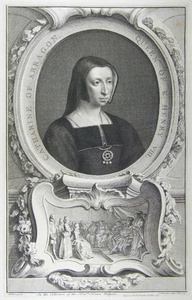| Method | Copper engraving |
| Artist | Jacobus Houbraken after Hans Holbein the Younger |
| Published | Impensis J. & P. Knapton Londini 1746 |
| Dimensions | Image 360 x 228 mm, Plate 371 x 237 mm, Sheet 494 x 343 mm |
| Notes |
Portrait of Louise of Savoy, incorrectly named as Catherine of Aragon. Turned to the right, she wears a dark headdress, and a simple dress with a large pendant over the top. Beneath the portrait is a cartouche depicting Catherine of Aragon before the papal legate. This portrait of Louise of Savoy is from Thomas Birch's The Heads of Illustrious Persons of Great Britain. The series, which was engraved by Jacob Houbraken and George Vertue, was originally issued from 1737 onwards in portfolios of four portraits. Between 1743 and 1752, the series was published by John and Paul Knapton in London in the form of Birch's The Heads of Illustrious Persons of Great Britain, and contained biographies alongside the portraits. The number of plates included varied from edition to edition. Although the majority contained 108 plates, some editions contained as many as 120. Houbraken was responsible for producing a large proportion of the portraits, with Vertue only engraving around seven. The ornamental surroundings featured on the plates were engraved prior to the portraits, and were done so by Hubert-François Gravelot. Louise of Savoy (1476 - 1531) was a French nobelwoman, Duchess of Auvergne and Bourbon, and the Duchess of Nemours. She was married to Charles of Orléans, with whom she had a son, King Francis I of France. Louise was politically active, and served as the Regent of France in 1515, 1525-6, and again in 1529. Catherine of Aragon (1485 - 1536) was the first wife of Henry VIII, and was therefore Queen of England between 1509 until 1536. Dissatisfied by his marriage to Catherine, with only a daughter born, and a growing infatuation with Anne Boleyn, Henry VIII sought to have their marriage annulled, which ultimately led to England's separation from the Catholic Church, and the formation of the Church of England. She had also previously been married to Henry VIII's brother, Arthur, and had gained the title of Princess of Wales through their marriage. Jacob, or Jacobus, Houbraken (1698-1780) was a Dutch portrait engraver, and dealer and collector of Rembrandt's etchings. Born in Dordrecht, he was the son of the artist Arnold Houbraken. In 1707 he moved to Amsterdam, where he assisted his father on a book of the lives of the Dutch Golden Age artists, entitled De Groote Schouburgh der Nederlantsche konstschilders en schilderessen (1718-1721). Between 1743 and 1752, Houbraken worked with George Vertue on Thomas Birch's Heads of Illustrious Persons of Great Britain. He also engraved the portraits for Jan van Gool's Nieuwe schouburg der Nederlantsche kunstschilders (1750-51). Between 1752 and 1759, he worked on Jan Wagenaar's Vaderlandsche historie, which was published by Isaac Tirion. Hans Holbein the Younger (1497 - 1543) was a painter, draughtsman and designer of woodcuts. He also worked with glass-paintings, metalwork, and jewellery. Holbein was born in Augsburg. He worked in Basel as a journeyman at the end of 1515, and was first employed there with Ambrosius by humanist scholars and their printers. In 1519, he was admitted to the painters' guild. With an introduction from Erasmus to Sir Thomas More he left for England at the end of August 1526 and stayed for two years working in the court circle before returning to Basel. He returned to England in 1532 and, under the patronage of Henry VIII, he produced a succession of magnificent portraits. The most famous of which was the mural painting glorifying the Tudor dynasty in the Whitehall Palace. It was regrettably destroyed in the fire of 1698. O'Donoghue 6, Ver Huell 84 Condition: Faint discolouration to sheet, not affecting image. A few small tears and creases to lower edge of sheet. |
| Framing | unmounted |
| Price | £80.00 |
| Stock ID | 40107 |

